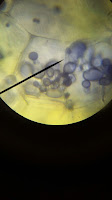We are going to do a paper chromatography.
MATERIAL:
-Mortal and pestle
-Scissor
-Funnel
-Graduated cylinder
-Beaker (250ml)
-Sand
-Ethanol
-Spinacks
-CaCO3
-Cellulose paper
PROCEDURE:

-Take ten spinacks
-Cut it in small pieces in the mortal (Not take the nerve)
-Put the sand in the mortal with a spatula
-Add CaCo3 in the mortal with a spatula
-Add 50ml the ethanol in the mortal
-Then you need to grind
-Filter this in a graduated cylinder with cellulose paper and put all in the beaker
-Create a small paper and put inside the beacker
-Create other small paper fold it and put into other beaker
QUESTIONS:
1.Why do we add sand?
For brake the cell and cloroplast.
2.Why do we add calcium carbonate?
For avoid the pigmnets degradesion.
3.Which is the colour of every pigmnets?
Clorofila green, xantofil yellow and carotenoide orange.
4.What adaptative purpose do differents colored pigmnets serve for a plant?
Because the light have diferents wave lenghts and the pigmnets take this diferents waves lenghts.
5.Why do they separate on the cellulose paper?
Because not all the pigmnets have the same solubility.


